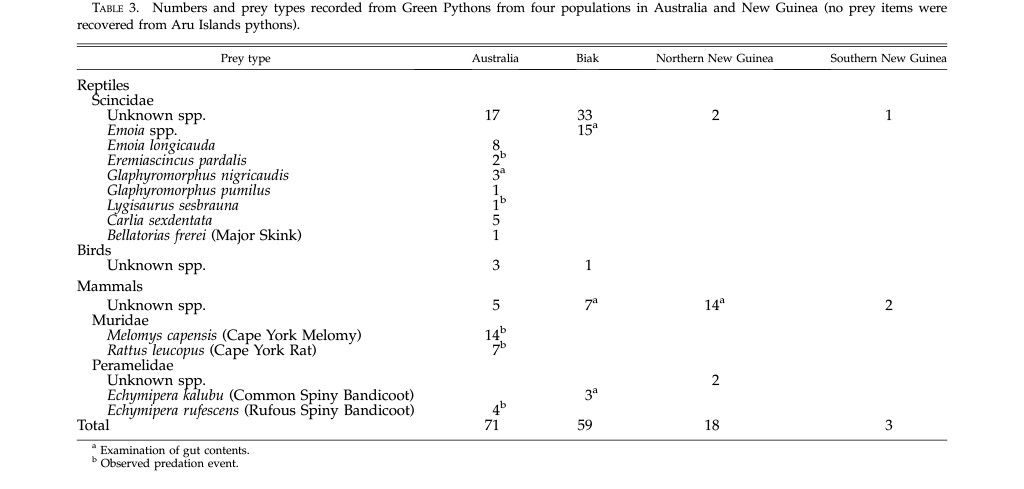Post by Ceratodromeus on Jan 19, 2016 23:49:46 GMT 5

Scientific classification
Kingdom: Animalia
Phylum: Chordata
Subphylum: Vertebrata
Class: Reptilia
Order: Squamata
Suborder: Serpentes
Family: Pythonidae
Genus: Morelia
Species: Morelia viridis
Description
This is a very slender, arboreal species of python. Like the common name may suggest, Morelia viridis is a lime green in color as an adult, with intermittent white or yellow dappling running down the spine of the animal. Young animals can be a brick red or bright yellow in coloration, but this typically changes to the green of the adults as the animal matures. Throughout the range of the species, adults measure at least 1m(3.3ft) in snout-ventral length. In a study published in 2014 dealing with the body size and morphology of this animal throughout it's geographic range, it was found that adult animals measured anywhere from 105-143cm(3.4-4.6ft) in snout-ventral length, a corroboration of other studies of the species{1,2}. The species is sexually dimorphic, though very slightly. Females being longer and heavier then the males; for example in the aforementioned study, females were approximately 10-20cm longer then males in snout-ventral length. A large female an measure as much as 1.7m(5.5ft) in snout-ventral length{1}.

Geographic distribution
This species is relatively wide spread, known from Northern Australia, and up into Papua New Guinea. Recent analysis has shown one population in Northern New Guinea to be a distinct species, Morelia azurea{3}. they are fairly sedentary animals, often staying in one tree for days at a time. Radio telemetry studies have shown one adult male staying in the canopy of a single tree for 28 days. These studies have also shown males are more prone to roaming from tree to tree, whilst females have distinct home ranges{4}.

Dietary habits
At one point in time, it was widely theorized that this species was a prolific avian specialist, due to its arboreal nature are cryptic green coloration that would allow them to ambush birds as they rest on branches. However dietary studies based off of the stomach contents of wild collected animals, have universally rejected this. Instead, we now know that these snakes, while the will on the odd occasion take a bird, feed mainly on small mammals and reptiles. These snakes experience an ontogenic change in their diet at the onset of maturity; young animals taking mainly ground based ectothermic prey, whilst adults prey mainly on arboreal and semi-arboreal endothermic animals{5}. In captivity, green tree pythons are known to use caudal luring -- wiggling the tip of the tail as to mimic the movement of small insects{6}. This is likely a behavior young animals utilize in the capture of small rodents and lizards, and the adults as well likely utilize this tactic.

Reproduction
Sexual maturity is achieved earlier in males then it is females, at shorter snout-ventral lengths; one study found the smallest sexually mature male to be 91cm(2.9ft) in snout-ventral length, while the smallest sexually mature female to be 1.12m(3.6ft){5}. Matins is not something that has been witnessed in the wild, but clutch size for the species has been noted at an average of 12, with as many as 19 or as little as 6 in a clutch{7}. When the neonates hatch, they are either a bright yellow or brick red in coloration. They will retain this coloration until the onsets of maturity, but even then some adult animals retain the red or yellow coloration throughout their lives.

References
{1} Natusch, Daniel JD, and Jessica A. Lyons. "Geographic and Sexual Variations in Body Size, Morphology, and Diet among Five Populations of Green Pythons (Morelia viridis)." Journal of Herpetology 48.3 (2014): 317-323.
{2} Wilson, D., R. Heinsohn, and J. Wood. "Life‐history traits and ontogenetic colour change in an arboreal tropical python, Morelia viridis." Journal of Zoology 270.3 (2006): 399-407.
{3} Barker, David G., et al. "A review of the systematics and taxonomy of Pythonidae: an ancient serpent lineage." Zoological Journal of the Linnean Society (2015).
{4} Wilson, David, Robert Heinsohn, and Sarah Legge. "Age‐and sex‐related differences in the spatial ecology of a dichromatic tropical python (Morelia viridis)." Austral Ecology 31.5 (2006): 577-587.
{5} Natusch, Daniel JD, and Jessica A. Lyons. "Relationships between ontogenetic changes in prey selection, head shape, sexual maturity, and colour in an Australasian python (Morelia viridis)." Biological Journal of the Linnean Society 107.2 (2012): 269-276.
{6} Murphy, James B., Charles C. Carpenter, and James C. Gillingham. "Caudal luring in the green tree python, Chondropython viridis (Reptilia, Serpentes, Boidae)." Journal of Herpetology (1978): 117-119.
{7} Shine, Richard, and David J. Slip. "Biological aspects of the adaptive radiation of Australasian pythons (Serpentes: Boidae)." Herpetologica (1990): 283-290.


